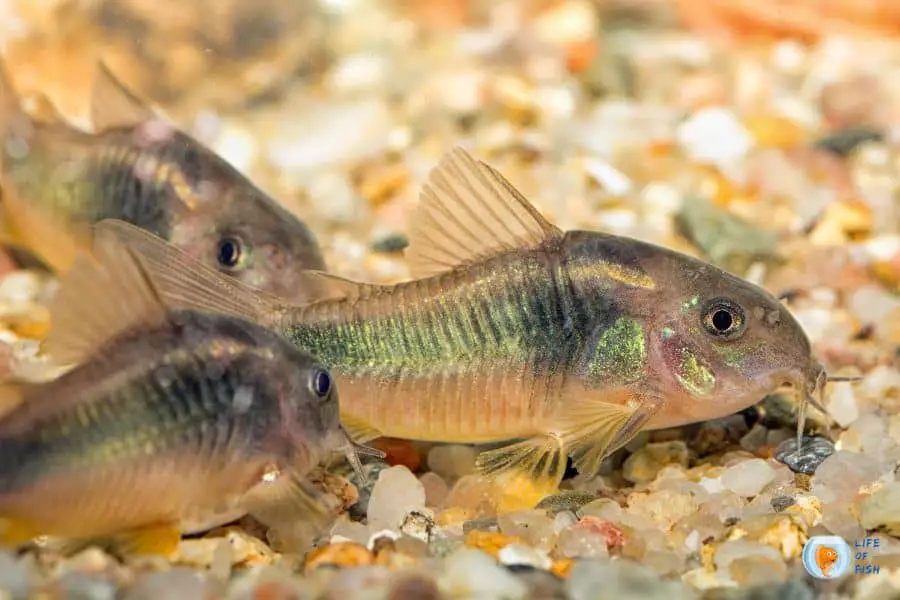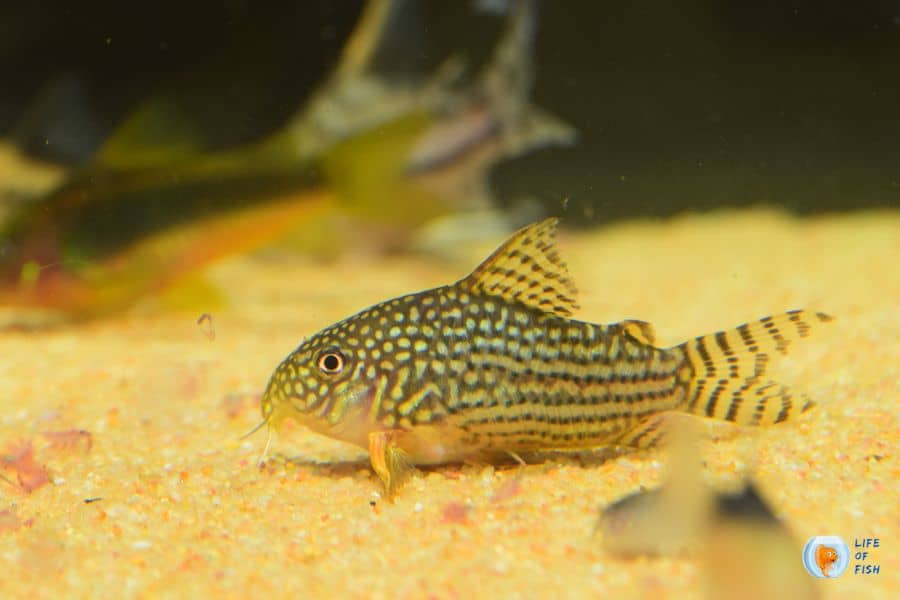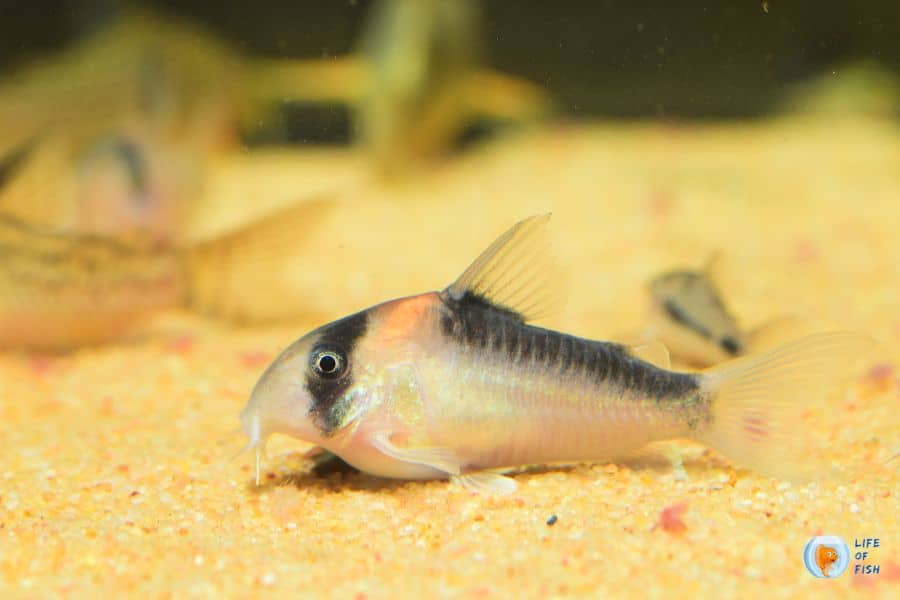Corydoras are the go-to fish for me when it comes to bottom-dwellers. They are relatively small, peaceful, and, most importantly – very easy to care for. This makes them ideal for beginner aquarists or for those who want to add some activity to their tank without worrying about compatibility issues.
While corydoras are not fussy when it comes to the substrate, there are still a few factors you should keep in mind when selecting the best substrate for Corydoras. While many prefer sandy substrate for cory catfish, these fish can actually live well on a variety of substrates, as long as it is clean and free of sharp objects that could injure their delicate barbels. In this article, I will talk about the best substrates for Corydoras tanks, as well as some that should be avoided.
However, to decide which substrate is best for corydoras, we have to explore where they come from and how this affects their captive habitat. So, let’s get started…

Where Do Corydoras Live In The Wild?
Jump To
- 1 Where Do Corydoras Live In The Wild?
- 2 What Does This Mean For Their Captive Habitat?
- 3 Can Corydoras Live Without Substrate?
- 4 Substrate Types For Corydoras
- 5 Best Substrate Color For Corydoras
- 6 What Is The Best Depth For Substrate?
- 7 What Substrate Is Easiest To Clean?
- 8 Bottom Line: What Is The Best Substrate For Corydoras
Corydoras originate from South America, in countries such as Brazil, Peru, and Columbia. You can find them in a variety of habitats, from slow-moving rivers and streams to swampy areas and lakes. As for the substrate, these guys mostly prefer sandy grounds. They can also be found on sandy grounds with leaf litter. However, they are not as common in areas with a gravel substrate. Yet alone, they are almost rare in muddy regions.
The substrate preferences usually vary by corydoras species. Smaller corydoras like C. albolineatus, C. napoensis, C. nanus, C. loretoensis, and C. Bondiare spread around leaf litter over sand because they provide necessary protection and nutrition to these smaller species. Many others, except pygmy species, are mostly found in fine sand. And when they do, it will be in hundreds, if not thousands.
Pygmy species like C. hastatus and C. pygmaeus can be found in almost any habitat because they are open-water swimmers. Whichever substrate type they choose to live in, they always choose an area with little to no water movement. And they prefer planted areas as well.
What Does This Mean For Their Captive Habitat?
While corydoras are not too picky regarding the substrate, they prefer a sandy bottom. This is because, in the wild, corydoras spend most of their time sifting through the substrate for food. A sandy substrate is much easier to sift through than a gravel one and is less likely to damage its barbels.
That being said, a gravel substrate can still be used for a corydoras tank, as long as it is not too large or sharp. These fish are bottom-dwellers, so they will spend most of their time near the substrate anyway. Make sure the gravel is not too big, as this could injure their barbels.
Another thing to keep in mind is that corydoras are from slow-moving waters. This means that they are not used to a lot of water movement in their tank. A filter with a strong flow is unnecessary, and it can be detrimental to these fish. A gentle filter is all that is needed to provide adequate filtration for a corydoras tank.
When it comes to plants, these fish prefer a tank with plenty of vegetation. This provides them with places to hide and feel secure, as well as places to lay their eggs. Java moss, hornwort, and anubias are all good plants for a corydoras tank.

Can Corydoras Live Without Substrate?
Corydoras can live without substrate, but it is not recommended. A bare-bottom fish tank is easier to clean, and the waste will be sucked up by the filter more easily, making it a good choice for fries. However, there will be less beneficial bacteria in a bare bottom tank, which can make a weaker biological ecosystem. Therefore, a bare bottom tank is not ideal as a long-term community tank. A bare bottom tank will suffice if you need a temporary tank for breeding or quarantining your fish. But for a long-term home, the substrate is necessary.
Substrate Types For Corydoras
Choosing a substrate for corydoras is not hard as you think, as these hardy fish can bear almost any substrate. Even though many believe that corys may injure their barbels because of sharp gravel, this is not true. They will be fine if the gravel is not too big. Otherwise, how can these fish migrate into the wild? That being said, here are some of the most common substrate types used for corydoras tanks:
Sand
The most popular substrate type for corydoras is sand. This is because sand is soft and easy on its barbels and easy to sift through. Sand is also relatively cheap and easy to find, making it a good choice for many hobbyists.
That being said, it can be difficult to clean if it gets too dirty and can also cloud the water. You must also consider the type of sand as well. Some types of sand can have lots of calcium, which can increase the hardness of your water. This is not ideal for corydoras, as they prefer soft to neutral water.
Pros
- Sand has a larger surface area for beneficial bacteria, providing a more natural and healthy environment for fish.
- Cory catfish love to dig around in the sand, just like they would in the wild.
- It is one of the cheapest substrates available, making it a good option for those on a budget.
Cons
- It can easily silt up, making it difficult to clean
- Not as good at holding onto nutrients as other substrates
- It can easily become clogged with debris
- Prone to compaction, which can make it difficult for plants to grow
What Sand Is Safe For Corydoras?
These fish are prevalent in rivers with sandy beds for a reason. Soft river sand is perfect for their barbels and is also easier for them to sift through in search of food. However, not all sand is created equal.
Some sand types, such as play sand and pool filter sand, can actually be harmful to these fish. These sands often contain high levels of silica, which can be abrasive to their barbels. In addition, these sands are often too fine and can easily be ingested by these fish. This can lead to digestive issues and, in some cases, death.
The best type of sand to use for a corydoras tank is aquarium-grade sand. Aquarium-grade sand is specifically designed for use in aquariums and is safe for all fish. It is also the perfect size for these fish and will not be ingested. Aquarium-grade sand can be found at most pet stores and is relatively cheap. A 50-pound bag should be enough to fill a 55-gallon tank.
Sand Size For Corydoras
When it comes to aquarium grade sand, it is also available in different sizes. The most common size is 0.5-2.0 mm, which is perfect for corydoras. This size is not too small, so it will not be ingested, but it is also small enough for them to sift through easily.
Another popular size is 2-4 mm. This site is a bit too large for corydoras, but you can still use it. These fish may have a harder time sifting through this sand, but they will still be able to do it. The larger size of this sand can also help to keep the water clearer, as it will not silt up as easily.
Gravel
Many hobbyists choose to use gravel in their corydoras tanks. This is because it is easy to find and is also relatively cheap. Gravel can also be found in a variety of colors, making it easy to create a visually appealing tank.
Gravel is also a good substrate for plants, providing them with nutrients and allowing their roots to anchor themselves. This can benefit a corydoras tank, as these fish love to hide among plants. However, gravel is not as soft on corydoras’ barbels as sand. In addition, some types of gravel can increase the hardness of your water. This is not ideal for corydoras, as they prefer soft to neutral water.
Pros
- Gravel is easier to vacuum clean than sand.
- Gravel does not get blown away as easily as sand.
- Gravel is less likely to get caught in the filters
- Gravel is a natural substrate that can help with plant growth
Cons
- Gravel is more difficult for Cory cats to dig through
- Gravel can cause higher pH levels in aquariums
- Gravel may cause impaction if ingested.
- Because gravel weighs more and has a smaller surface area than sand, it doesn’t have as many good bacteria.

What Gravel Is Safe For Corydoras?
The best type of gravel to use for a corydoras tank is aquarium-grade gravel. This gravel is specifically designed for use in aquariums and is safe for all fish. It is also the perfect size for these fish and will not be ingested. Aquarium-grade gravel can be found at most pet stores and is relatively cheap. A 50-pound bag should be enough to fill a 55-gallon tank.
Gravel Size For Corydoras
When it comes to aquarium grade gravel, it is also available in different sizes. However, the size of gravel is a bit larger than sand. The smallest size is 2-4 mm, which is a bit too large for corydoras. Yet, your corydoras will do fine in this gravel as long as they are not sharp and bright colored. Any size above that is too large and can potentially stress your fish as they can’t dig and sift through it well.
Types Of Gravel
When searching for gravel to use for your cory catfish, there are a few types you can choose from.
- Pebbles
Pebbles are a smaller type of aquarium substrate. They usually range from a few millimeters to a few centimeters in size. This type of substrate is generally better for cory catfish and fish tanks. It provides more surface area for beneficial bacteria, and plants have an easier time growing roots. Cory catfish also can dig in this substrate because it’s smaller and lighter.
- Aquasoils
Aquasoils are very popular among more experienced aquarists, aquascapers, and highly planted tanks. They are considered more premium options, but they are the best soil in most cases. Aquasoils are often porous clay or volcanic soils. They are just small enough for cory catfish and the ideal size for plants to grow roots.
- Colored gravel
Some people prefer to use colored gravel in their tanks, but I would not recommend it. The bright colors can be stressful for the fish, and you can’t grow plants with colored gravel. Further, the color may fade over time and look ugly.
- Classic crushed stones
Classic crushed stones are usually prepared out of smaller stones and bigger versions of sand. They are usually sharp, which can damage the barbels of your corydoras. It is not a good substrate option for plant growth and is difficult to clean. I do not recommend using this substrate.

Best Substrate Color For Corydoras
The best substrate color for corydoras is a dark one. This can be black, brown, or dark gray. The darker colors will help to make the fish feel more comfortable and less stressed. In addition, dark colors will also help to make the tank look more natural. Avoid using bright colors, as these can be stressful for the fish. In addition, bright colors can make it difficult to see the fish, which is not ideal.
What Is The Best Depth For Substrate?
The best depth for the substrate is around 2-3 inches. This will provide enough room for the fish to dig and sift through the substrate while also providing enough space for plants to grow. In general, you should avoid using more than 3 inches of substrate. This can be difficult to clean and can also make it difficult for the fish to move around.
What Substrate Is Easiest To Clean?
Although corydoras prefer sand substrate over gravel substrate, gravel is the easiest to clean. This is because you can suck up gravel easily with a gravel vacuum. Sand, on the other hand, can be more difficult to clean. This is because it can be easily stirred up, making it more difficult to vacuum.
Bottom Line: What Is The Best Substrate For Corydoras
Now that you know more about the different types of substrates, you may be wondering what the best substrate for corydoras is. Many elements play a part in answering this question, including the size of your tank, the type of fish you have, and how much money you’re willing or able to spend.
In general, the best substrate for corydoras is sand. This is because sand is softer and more comfortable for the fish. In addition, sand provides a better environment for plants to grow. If you have a small tank, you may want to consider using gravel. This is because gravel is easier to clean and can be less expensive. No matter what substrate you pick, ensure that it is the right size for your fish. Smaller gravel or sand is better for corydoras, as it will not damage their barrels.
Read Next : Are X-ray Tetras Aggressive? And What Fish Can Live With Them?
